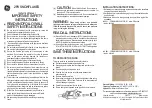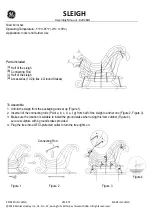
LX113
V. 05 – 07/04/2014
5
©Velleman nv
The carrying construction must be able to support 10 times the weight of the device for 1 hour
without deforming.
The installation must always be secured with a secondary attachment such as a safety cable
(e.g. VDLSC7N or VDLSC8N). The secondary attachment shall be designed and mounted in such a
way that no part of the device can fall if the primary attachment fails.
Make sure that the safety cables can carry 10 times the weight of the device. Make sure that the
maximum height of drop is limited so that no injuries can occur. If the safety cables are long, wrap
them around the truss multiple times to reduce the height of drop to a safe level.
Never stand directly below the device when it is being mounted, removed or serviced. Have a
qualified technician check the device once a year and once before you bring it into service.
Install the device in a location with few passers-by that is inaccessible to unauthorised persons.
Overhead mounting requires extensive experience: calculating workload limits, determining the
installation material to be used… Have the material and the device itself checked regularly. Do not
attempt to install the device yourself if you lack these qualifications as improper installation may
result in injuries.
For truss mounting, use an appropriate clamp (not incl.) and fit an M10 bolt through the centre of the
(folded) bracket.
Adjust the desired inclination angle via the mounting bracket and tighten the bracket screws.
Make sure there is no flammable material within a 0.5 m radius of the device.
Coffin Locks
The device has coffin locks for horizontal alignment.
These locks are for alignment purposes only and cannot be used to support the device.
Additional hardware is required for mounting.
8.
Connections
8.1
Power Connections
Have a qualified electrician carry out the electric connection.
Connect the device to the mains with the power plug. All devices must be powered directly off a
grounded switched circuit.
Never connect the device to a rheostat or dimmer, even if the rheostat or dimmer channel is used
solely for 0 % to 100 % switching.
The device has a power output to supply power to another device. When connecting several devices
in a daisy chain via this output, make sure that the total current does not exceed the power line’s
nominal current. Use power cables with an adequate section.
The installation has to be approved by an expert before the device is taken into service.
Disconnect after use.
Power Linking
You can link up to 28 devices at 230 V (15 devices at 120 V). Never exceed this number. Power linking
cords can be purchased separately.
Data Linking
The device works connected through a network switch (or crossover cable) to a controller or computer
(Windows®, Apple Macintosh® or Linux®) with Kling-Net/Art-Net compatible software installed.
Data Connection
With Kling-Net/Art-Net, the device uses an RJ45 data connection to link all data ports.
8.2
DMX Linking
The device works with any DMX controller with a DMX serial connection.
DMX-512 Connection
When applicable, connect an XLR cable to the female XLR output of a controller (not incl.) and the
other side to the male XLR input of the device. Multiple devices can be linked through serial linking.
The linking cable shall be a dual core, screened cable with XLR input and output connectors.
Maximum recommended serial data link distance is 500 meters (1640 ft). Maximum recommended
number of devices on a serial data link is 32 devices.






























